Addressing heat distress in dogs
Dr Aine Seavers MVB MRCVS provides advice that vets can share with clients on how to look after their dogs during warm spells
This article was first written to give alternatives to owners in warmer climes who do not have air-conditioning spaces for their dogs, rabbits or older cats to seek refuge in during hot spells.
The original Australia-based version went viral and continues to have a global reach.
However extreme weather conditions are not the sole determinant of heat stroke potential. Some of the worst cases of heat stroke we treated were in London and Dublin, where owners inadvertently created a perfect scenario to induce heat distress in their dogs:
the locked-in-car scenario;
the epileptic seizuring dog incorrectly wrapped in a bundle of blankets and then transported in a heated car to the vet;
or
the worst presentations: Obese and Separation-Anxious dogs left corralled into small areas of the house that were inadvertently de-facto sun-traps; think skylights, glass-fronted porches and hallways, conservatories etc.
Now, with the additional issues of climate change and the increased movement of a new cohort of owners taking their dogs away with them to the continent, the potential of cooler climate dogs to be suddenly exposed to extreme weather stress conditions becomes a concern. I hope this article will help Irish veterinary surgeons better prepare their clients to address heat stress prevention in their dogs. Links to some of the products mentioned in the article can be found at the very end of the article.
There are several basic ways to keep a dog cool in summer: but it is amazing how often these basic steps are overlooked with the result that the dog (thermoneutral zone 20o-30o) presents with heat-related complications.
Fans alone are not the solution!
Fans alone will not cool down dry dogs to any significant degree.
Please share this warning with dog owners as we frequently see heat-distressed dogs whose owners have thought using fans will cool the dog down. Thinking a fan is “better than nothing” is dangerous thinking; that logic has resulted in owners relaxing, thinking that their dog will be ok once the fan is on. If the temperature is soaring and or the dog is showing signs of heat distress, do not be lulled into a false sense of security that putting on the fans is all that is needed to be done to help the pet.
Fans work on humans because we sweat profusely over a large part of our bodies; dogs only sweat from specific non-furred areas of their bodies. To cool a dog down using a fan, one has to first wet the dog. down. Once the dog is wet, place the damp/wet dog near a fan in the fan’s airstream, making sure to keep any water away from all electrical items.
Putting a heat-distressed dog in the shower and running cool or iced water fast over the dog and working the water into the fur and onto the skin will help as well.
A wet shirt will work on a short-haired breed but does not work so well on a well-haired breed.
If a pet owner uses a hose to spray their dog down, they should flush out the water in the hose first. That first water can often be very warm, to the point we have seen dogs and rabbits in hotter climes scalded by that initial stream of hose water.
Leaving a water sprinkler on in non-drought times can be very helpful to the dog.
Many large retail or toy store-style outlets sell large clam-shaped play or sand pits for human children. The half-clam shells work great for dogs when filled with water. Just make sure the pits are placed or stored under shade.
If the client owns a smaller dog, make sure that they only shallow-fill the clam with water to below the dog’s lying height, if they are leaving the dog unattended for any period of time. Research has revealed that Greyhounds immersed in a cold-water bath in a cooling shell will cease to pant in three minutes. It is therefore well worth having one of these shells or a large storage tub filled with cold water in any dog-family backyard.
If the client doesn’t have space for a clam or tub, just soaking an old material-based dog bed or a bunch of blankets with cold water for the dog to sit on also assists the pet in keeping cool.
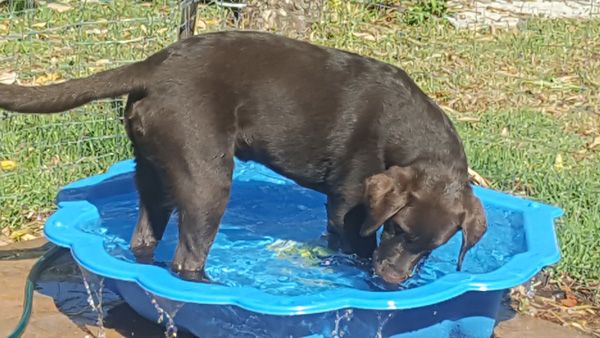
A cold water bath providing relief from high ambient heat.
Ice
Ice cubes lined up into a plastic freezer bag, then slid into a long sock make for a great cooling pack. For a heat-distressed dog, the ideal approach is to place this long, cylindrical icepack into the dog’s axilla/armpit, and inguinal/groin areas. Ice, applied to these areas is more beneficial to the heat-distressed dog than placing ice/cold water just about anywhere else on the dog’s body.
The dog owner can also freeze plastic water bottles, slip these into an old sock and sit that combination in the dog’s groin and armpit areas or just lie up against the dog’s belly. Remember to remind and explain to the owner how not to put the ice on the feet area as that makes the dog’s brain perceive the dog to be cold, which then triggers a cascade of triggers trying to stop the dog losing heat. The workaround is to cheat and place the wrapped ice directly in the axilla and inguinal area.
Emergency vet visits
If dog owners need to rush their pet to the vet:
- They should start cooling the dog down before putting the pet into the car.
- Open all the windows in the car, let the heat out and run the air conditioning to cool the car down before putting the dog in the car.
- If the owners don’t have air-con in the car: place a damp towel loosely on the dog and/or place wrapped ice bricks in the dog’s armpits. Then drive to the destination with windows down to let the breezes in.
- Restrain the dog safely in the car. Do not wrap a heat-collapsed dog or any seizuring animal in a blanket and do not hug it to the body while you race to the vet. The dog must be allowed to keep cool (not frozen either) on the journey
Even if the dog has recovered at home from a heat-collapse episode, the owner should ring the vet, advise them of the event, and organise to have the animal checked (at a cooler time of the day) for any problems related to circulation or liver and kidney function.
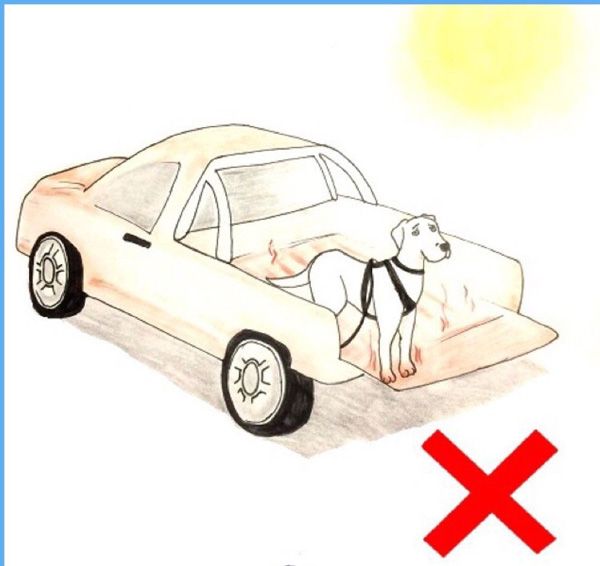
The back of an uncovered truck is a potential burn surface for dogs’ paws.
Prevention
Do not walk any dog on an overly hot day. If you do want to take the dog for a walk, even in the “cooler” part of the morning and evening, first walk outside barefoot onto the path and road you want to walk the dog on. If the owners’ own feet are finding it hot and uncomfortable, spare a thought for the poor dog who has to go for a long walk with them! It is no wonder dogs chew and lick their feet more in summer, but the manic licking is not just triggered by allergies and cut-grass contact issues but also by direct contact thermal damage. Often the dog suffers a degree of burnt and painful pads and toes from those daily walks on hot tarmac and concrete that the owner consistently fails to realise has occurred.
A more recent advice trend I noticed from the northern hemisphere is to have the owner bend down and place the back of their hand on the pavement for five seconds to test the ground heat. Aside from many elderly/disabled/injured owners being unable to bend down anyway, let alone along with a dog frantically pulling at the leash, my concern is the skin on our hands is far more tolerant of heat extremes than the skin on the soles of our feet, especially if you are used to wearing shoes or socks all year round.
Even in Australia where shoes are only worn under duress in the warmer areas so the soles of their feet are less sensitive, one can still easily get immediate feedback when quickly testing the ambient ground temperature with one’s bare foot. My preference, therefore, is for the owner to slip their foot out of their footwear in order to run a pavement heat check.
Remember to watch the back of uncovered trucks or tractor trays as another potential burn surface for the dog’s feet.
Walking the dog on grass can be more pleasant for the dog if it is not allergic to grass. Avoid areas of freshly mown or mulched grass, especially if these areas have been recently sprayed by local councils etc. Many dogs will react to the freshly mown or chemically-treated grass.
Synthetic sports surfaces and artificial grass can reach dangerously high temperatures. Avoid these synthetic play surfaces and sports grounds on walks. I would ask owners to please not resurface their own dog’s whole backyard with these synthetic grass products. With small dogs having low clearance, we see also abrasions and burns on their bellies from these synthetic grasses, in addition to the sore or singed feet on all sizes of dogs.
If you need to rinse the dog’s feet after a walk, cool water, or a 50/50 mix of white vinegar and water, is a safe solution to clean or soothe a sore paw. Do not use TCP, Dettol, Savlon etc. on the dog’s feet (or anywhere else on their body either).
Boots/Shoes
If you do insist on taking the dog for a walk, consider a set of protective dog boots for the dog. Since 9/11 and the loss of many rescue dogs in the days afterwards from damaged pads, most police and rescue dogs wear these boots as the norm, so there are now many online outlets selling these boots.
At the end of this article, there is a link to an article that compares eight types of boots including boots types most suitable for hot surface work.
However, no boot etc. will protect smaller dogs and puppies from the radiant heat beaming back up off hot concrete, striking dogs on their underbelly, face, eyes and ears. These little dogs exist and walk in an almost separate micro-climate to that of tall dogs and humans. The closest humans would get to experience what it is like is when blasts of radiant heat coming off hot concrete hit exposed human shin skin – most unpleasant. But just imagine if the eyes, face and mouth were also being basted like that on a long walk... which is exactly what is happening to a small dog on its walk.
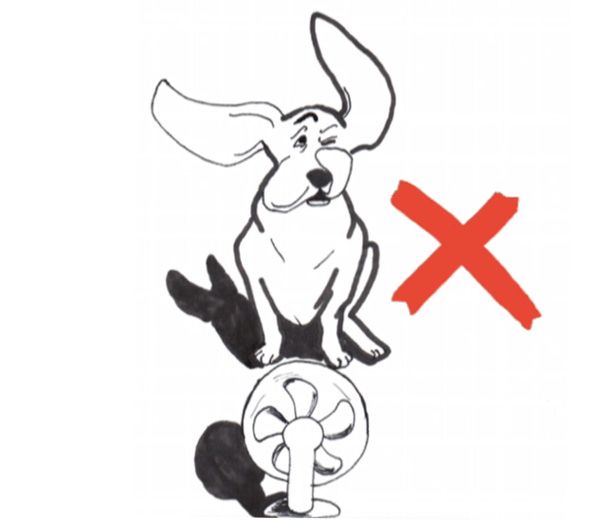
Fans alone are not the solution
Pet Strollers
One item that is becoming very popular in warmer countries is the use of dog-specific strollers so that old or injured dogs can still get out and about. Some of my clients have kindly provided images of very sturdy dog strollers that they use: the stroller can also double up as a type of walking frame support for an injured human owner and provides a means of giving an elderly dog the mental stimulation of going out for a walk with the rest of the family in all types of weather. On warmer days, the prams provide shade from the sun and reflected heat. Owners will sit the dogs on cooling pads or beds inside the pram and will dampen the outside cloth down to provide an increased cooling effect.
Wonderful as this dog stroller option is, my own preference is that all dogs stay home when the ambient temperature has either suddenly surged several degrees over 25o or when it is a regular> 30o.
Length of the Walk
Never take the dog out for a walk if the ambient temperature is consistently >30o or there has been a sudden warm spell > 25o to which that the dog has not had time to acclimatize.
Aside from those scenarios-a maximum walk duration should be 20 minutes for an excitable or hyperactive dog, that is 10 minutes out and 10 back. For a calmer, slower dog, 30 minutes is the maximum.
These are strict maximums. It is still up to the owner, taking all the issues mentioned above into account, to make sure the walk lasts no longer than is safe for an individual dog, even if that means no walk at all that day.
As a vet, it is sad to see an owner bring a now dying, previously healthy, dog that had been taken for a walk simply because the owner thought their pet was fit enough to cope with the extreme heat.
Length of the Coat
Shaving long-haired dogs helps cooling methods considerably, to the point that some Australian emergency specialist vets believe that shaving heat-stroke dog patients has saved the dog’s life.
Research has shown reducing fur thickness from 10mm-5mm could lower body temperature, especially where the ambient temperature is above 35o.
Too long a coat can also interfere with the effectiveness of cooling clothing. Ideally, the dog should be visiting a dog groomer no later than late spring each year to help prepare the coat for the upcoming heat.
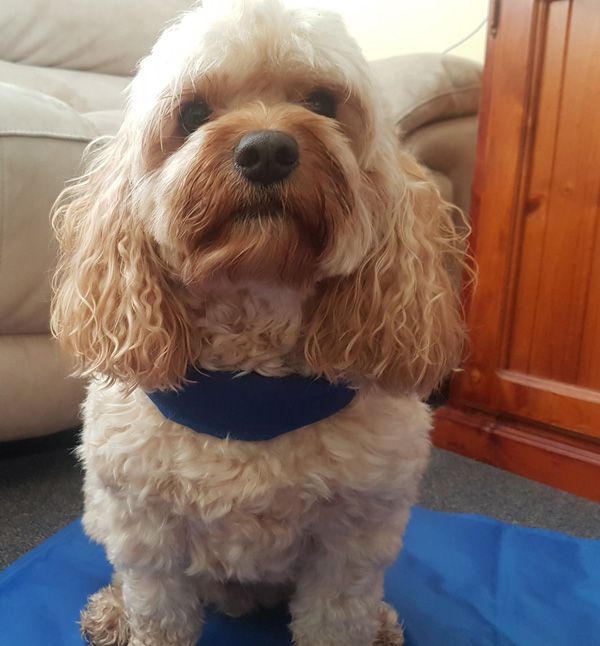
A cooling collar.
Cooling Clothes for the Dog
Cooling Collars
We have as yet no personal experience of using these types of collars.
Recent work in human medicine validates cooling the neck area in humans to reduce vasoconstriction of the carotid artery to help prevent heat-stroke-induced reduction of blood supply to the brain. The work on carotid cooling works in man has been extrapolated superbly to horses where similar anatomy ensures it is effective. But can we claim the same carotid cooling effect in dogs/cats given the differences in their anatomy?
Unfortunately, it appears that we can’t extrapolate from humans/horses to dogs re cooling collars.
The heat exchange mechanism below the brain in dogs means that cooling the carotids is unlikely to be an effective strategy to avoid heat stroke in dogs.
In addition, the sheer weight on the dog’s neck from the collar when wet has always been a concern for me. Perhaps the safest advice for those owners who purchased the cooling collars is to use them at home as a general cooling pad for the dog.
Ice-Vests for Dogs
Most dogs love these vests which are great to keep the pet cool when walking.
The vests are not an excuse to run the dog ragged, but rather to allow the pet to cool faster during and after a walk.
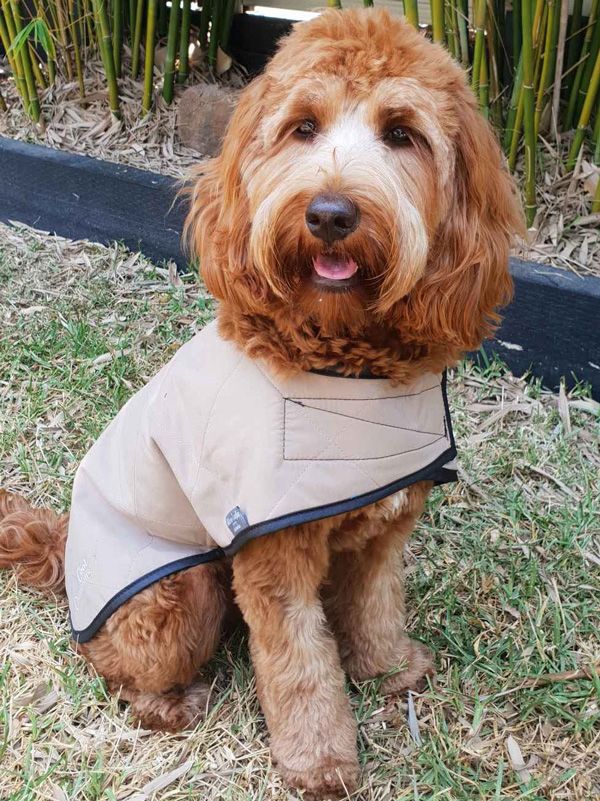
A cooling vest.
Drinking Bowls
Make sure you have more than one water bowl out as some dogs like to drink, finish up then tip the bowl over to empty it, leaving the dog and its pals now without any source of drinking water.
Refill bowls with fresh cold water each time.
Keep the bowls in the shade and avoid plastic or steel bowls in the warmer months.
In extreme heat, some of our clients provided a bowl of Lectade electrolyte replacement for dogs (https://tinyurl.com/2pokxlmu).
There are some smart ‘chill bowls’ that keep the water cold for hours. The preference is for a design where only the cooling insert is put in the freezer to activate, not the actual bowl from which the dog drinks. Keeping the dog’s actual drinking bowls away from areas of human food storage and preparation is a more hygienic approach.
If the dog is a chewer of all sorts of weird objects, then you need to ensure the freezer insert for this bowl is not something the dog could be at risk of chewing. If so, look at other cold-bowl options that represent less of a chewing opportunity.
Freezing large ice blocks in old ice cream containers overnight and tipping them out into the water bowl or onto the grass the next morning makes a great treat for the dog.
Taking chilled water or ice cubes in a sports bottle for the dog to access on a walk is helpful.
Ice cubes in the water bowl indoors and outdoors are also a good tip to help keep the dog cool. This is especially important for the short-nosed pugs and bulldog-like breeds, who get heat distressed very easily.
Cool Beds
Simple things like letting the dog lie on cool tiles or wetting a towel to have them lie on can help keep the dog comfortable.
As mentioned above, you can get cooling mats of different types for dogs. I like the Cool Champion blanket as it is lightweight, folds up small and you only need water to activate it, so great to have handy in the car or when travelling.
Mats for use in the home can be as simple as the Chill-out Cooling Mat or Mattress topper. These mats are sold for humans and are great for migraine sufferers to keep cool, but they work well for our dogs. These mats are not as versatile as the Champion coolmats but are still useful. Placing the plastic mats in the fridge for about 15 mins before use can cool these mats down even more. Again, don’t leave the dogs unsupervised when lying on these mats as you don’t want the dogs to chew or swallow the contents. Pet and retail stores also sell a cool gel beds for dogs. Again, do not leave unsupervised on these beds in case the dogs chew the filling.
Beach Visits
If you do take the dog for a cooling swim, consider whether you can safely carry them to and from the water, (without injuring your own back in the process) as hot sand in heatwave conditions in hotter climes can also be very very painful to all to walk on. Just ask anyone who visited Australia for the first time and ran headlong barefoot onto Bondi Beach in the summer. Some European beaches have the same startling effect when walked on barefoot or on paws.
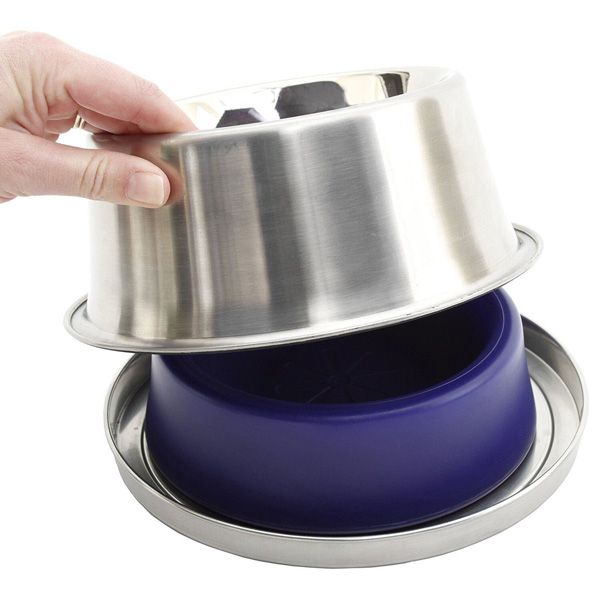
An example of a dog bowl with a cooling insert.
Geriatric dogs
Senior to elderly dogs can be hiding the early onset of heart or kidney disease until the warm weather hits and suddenly their health will deteriorate literally overnight. Slowing down, sleeping more, a soft cough or reluctance to get up can be signs of heart distress. Please see the vet if the dog is showing any of these signs. In the interim, if the owner has air-conditioning, then put it on for the dog, if not for themselves.
Sunburn
Dogs burn too. Filtabac cream is suitable as a sunblock for most dogs but, as always with any new product, always patch-test a small area on the dog first to make sure there is no reaction.
Dogs can be additionally protected with a T-shirt or a RASH Vest. An example of a Rash/Sun vest supplier is www.fluppies.com.au.
Always Have A Plan B
While keeping the dog inside with the air conditioning on is the best option, we do suffer electrical power failures when the demand for electricity soars.
Keep spare ice blocks and bags aside for the dog and perhaps keep some wet towels in the spare beer fridge and/or freezer to use in an emergency.
This article relates specifically to dogs. It is important to note that requirements differ for other pets such as cats or birds.
Links
*Boots: http://tinyurl.com/y87sguwm
Video of Tyson wearing his ‘AFP’ boots as he walks on the grass.
Vests/Mat: http://www.coolweave.com.au/k9_cooling_vest.htm
Collars: http://www.personalcoolingproducts.com.au/.
http://k9softdogcrates.com.au/polar/polar-collars.
Bowls: //www.frostybowlz.com/FrostyBowlz_Chilled_ dog_Bowl_p/3700.htm
Photographs courtesy of author. Drawings courtesy of D Chilcott and author.
The author extends her thanks to The Central for Veterinary Education, Sydney University, to Dr Terry King, Dr Jane Mc Nicholl and Dr Meg Brownlow for sharing their extensive expertise in heat distress in dogs. Much of the information contained above is a compilation of the wonderful answers these veterinary experts have provided to the many recent questions that Australian vets raised in the Sydney University’s Center for Veterinary Education’s Control & Therapy Journal.
1. Which are correct regarding the use of fans in heat-distressed dogs?
A. For a fan to be effective in cooling the patient-the patient must first be wetted down, then placed in a safe area in the fan’s airstream
b. A fan is the most effective way to keep a dog cool in warm weather.
c. Never use any fan on any heat-stressed patient
d. Do not leave the patient in option A unattended so as to avoid inadvertent patient over-cooling once their body temperature has stabilised.
2. Where are the best areas on the body to place wrapped ice packs on a heat-stressed dog?
A. Paws
b. Carotid Area
c. Axillae
d. Inguinal Area.
3. Research showed that heat-stressed Greyhounds immersed in a cool bath will:
A. Cease to pant in three minutes
b. Cease to pant in 10 minutes
c. Show an elevated breathing pattern that persists for 30 minutes.
d. Run slower times for 24 hours.
4. What is the thermoneutral zone for dogs?
A. 30o-38o
b. 20o-30o
c. 15o-19o
d. 35o-45o
ANSWERS: 1A and D; 2C and D; 3A; 4B.














